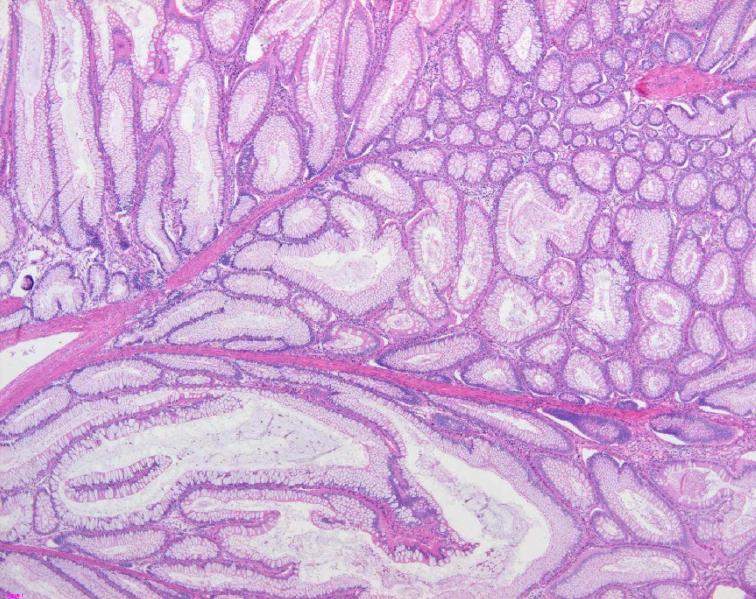Peutz-Jeghers syndrome pathophysiology: Difference between revisions
Jump to navigation
Jump to search
Hamid Qazi (talk | contribs) |
Hamid Qazi (talk | contribs) No edit summary |
||
| Line 7: | Line 7: | ||
==Pathophysiology== | ==Pathophysiology== | ||
===Pathogenesis=== | ===Pathogenesis=== | ||
*It is thought that Peutz-Jeghers syndrome is the result of deletion or partial deletion of STK11 (LBK1) gene, located on chromosome 19p13.3.<ref name="KopacovaTacheci2009">{{cite journal|last1=Kopacova|first1=Marcela|last2=Tacheci|first2=Ilja|last3=Rejchrt|first3=Stanislav|last4=Bures|first4=Jan|title=Peutz-Jeghers syndrome: Diagnostic and therapeuticapproach|journal=World Journal of Gastroenterology|volume=15|issue=43|year=2009|pages=5397|issn=1007-9327|doi=10.3748/wjg.15.5397}}</ref> | *It is thought that Peutz-Jeghers syndrome is the result of deletion or partial deletion of STK11 (LBK1) gene, located on chromosome 19p13.3.<ref name="KopacovaTacheci2009">{{cite journal|last1=Kopacova|first1=Marcela|last2=Tacheci|first2=Ilja|last3=Rejchrt|first3=Stanislav|last4=Bures|first4=Jan|title=Peutz-Jeghers syndrome: Diagnostic and therapeuticapproach|journal=World Journal of Gastroenterology|volume=15|issue=43|year=2009|pages=5397|issn=1007-9327|doi=10.3748/wjg.15.5397}}</ref> | ||
*STK11 protein plays an important role in second messenger signal transduction and is found to regulate cellular proliferation, controls cell polarity, and responds to low energy states. | *STK11 protein plays an important role in second messenger signal transduction and is found to regulate cellular proliferation, controls cell polarity, and responds to low energy states. | ||
* In Mammalian studies, STK11 is shown in the inhibition of AMP-activated protein kinase (AMPK), and signals downstream to inhibit the mammalian target of rapamycin (mTOR).<ref name="KopacovaTacheci2009">{{cite journal|last1=Kopacova|first1=Marcela|last2=Tacheci|first2=Ilja|last3=Rejchrt|first3=Stanislav|last4=Bures|first4=Jan|title=Peutz-Jeghers syndrome: Diagnostic and therapeuticapproach|journal=World Journal of Gastroenterology|volume=15|issue=43|year=2009|pages=5397|issn=1007-9327|doi=10.3748/wjg.15.5397}}</ref> | *In Mammalian studies, STK11 is shown in the inhibition of AMP-activated protein kinase (AMPK), and signals downstream to inhibit the mammalian target of rapamycin (mTOR).<ref name="KopacovaTacheci2009">{{cite journal|last1=Kopacova|first1=Marcela|last2=Tacheci|first2=Ilja|last3=Rejchrt|first3=Stanislav|last4=Bures|first4=Jan|title=Peutz-Jeghers syndrome: Diagnostic and therapeuticapproach|journal=World Journal of Gastroenterology|volume=15|issue=43|year=2009|pages=5397|issn=1007-9327|doi=10.3748/wjg.15.5397}}</ref> | ||
** The mTOR pathway is dysregulated in Peutz-Jeghers syndrome. | ** The mTOR pathway is dysregulated in Peutz-Jeghers syndrome. | ||
* Mucutaneous Pigmentation (macules) | * Mucutaneous Pigmentation (macules) | ||
** Caused by pigment-laden macrophages in the dermis | **Caused by pigment-laden macrophages in the dermis | ||
===Pathology | ===Genetics=== | ||
*Peutz-Jeghers syndrome is inherited in an [[autosomal dominant]] pattern. | |||
==Associated Conditions== | |||
*Breast Cancer | |||
*Colon Cancer | |||
*Pancreatic cancer | |||
*Ovarian cancer | |||
*Cervical cancer | |||
*Testicular cancer | |||
==Gross Pathology== | |||
*Peutz-Jeghers syndrome associated polyps have a unique smooth muscle core that arborizes throughout the polyp.<ref name="KopacovaTacheci2009">{{cite journal|last1=Kopacova|first1=Marcela|last2=Tacheci|first2=Ilja|last3=Rejchrt|first3=Stanislav|last4=Bures|first4=Jan|title=Peutz-Jeghers syndrome: Diagnostic and therapeuticapproach|journal=World Journal of Gastroenterology|volume=15|issue=43|year=2009|pages=5397|issn=1007-9327|doi=10.3748/wjg.15.5397}}</ref> | *Peutz-Jeghers syndrome associated polyps have a unique smooth muscle core that arborizes throughout the polyp.<ref name="KopacovaTacheci2009">{{cite journal|last1=Kopacova|first1=Marcela|last2=Tacheci|first2=Ilja|last3=Rejchrt|first3=Stanislav|last4=Bures|first4=Jan|title=Peutz-Jeghers syndrome: Diagnostic and therapeuticapproach|journal=World Journal of Gastroenterology|volume=15|issue=43|year=2009|pages=5397|issn=1007-9327|doi=10.3748/wjg.15.5397}}</ref> | ||
**These polyps can only be differentiated from other polyp types by histopathology. | **These polyps can only be differentiated from other polyp types by histopathology. | ||
===Microscopic Pathology=== | ===Microscopic Pathology=== | ||
Polyps of Peutz-Jeghers syndrome are usually non-neoplastic [[hamartomas]].<ref>Pathology of Peutz-Jeghers syndrome. Dr Amir Rezaee and Dr Alexandra Stanislavsky et al. Radiopaedia.org 2015. http://radiopaedia.org/articles/peutz-jeghers-syndrome-2</ref> On microscopic histopathological analysis, polyps have the following characteristic findings:<ref name="BuckHarned1992">{{cite journal|last1=Buck|first1=J L|last2=Harned|first2=R K|last3=Lichtenstein|first3=J E|last4=Sobin|first4=L H|title=Peutz-Jeghers syndrome.|journal=RadioGraphics|volume=12|issue=2|year=1992|pages=365–378|issn=0271-5333|doi=10.1148/radiographics.12.2.1561426}}</ref> | Polyps of Peutz-Jeghers syndrome are usually non-neoplastic [[hamartomas]].<ref>Pathology of Peutz-Jeghers syndrome. Dr Amir Rezaee and Dr Alexandra Stanislavsky et al. Radiopaedia.org 2015. http://radiopaedia.org/articles/peutz-jeghers-syndrome-2</ref> On microscopic histopathological analysis, polyps have the following characteristic findings:<ref name="BuckHarned1992">{{cite journal|last1=Buck|first1=J L|last2=Harned|first2=R K|last3=Lichtenstein|first3=J E|last4=Sobin|first4=L H|title=Peutz-Jeghers syndrome.|journal=RadioGraphics|volume=12|issue=2|year=1992|pages=365–378|issn=0271-5333|doi=10.1148/radiographics.12.2.1561426}}</ref> | ||
Revision as of 16:27, 20 December 2017
|
Peutz-Jeghers syndrome Microchapters |
|
Diagnosis |
|---|
|
Treatment |
|
Case Studies |
|
Peutz-Jeghers syndrome pathophysiology On the Web |
|
American Roentgen Ray Society Images of Peutz-Jeghers syndrome pathophysiology |
|
Risk calculators and risk factors for Peutz-Jeghers syndrome pathophysiology |
Editor-In-Chief: C. Michael Gibson, M.S., M.D. [1] Associate Editor(s)-in-Chief: Hamid Qazi, MD, BSc [2]
Overview
Peutz-Jeghers syndrome is transmitted in an autosomal dominant pattern. Polyps of Peutz-Jeghers syndrome are usually non-neoplastic hamartomas.
Pathophysiology
Pathogenesis
- It is thought that Peutz-Jeghers syndrome is the result of deletion or partial deletion of STK11 (LBK1) gene, located on chromosome 19p13.3.[1]
- STK11 protein plays an important role in second messenger signal transduction and is found to regulate cellular proliferation, controls cell polarity, and responds to low energy states.
- In Mammalian studies, STK11 is shown in the inhibition of AMP-activated protein kinase (AMPK), and signals downstream to inhibit the mammalian target of rapamycin (mTOR).[1]
- The mTOR pathway is dysregulated in Peutz-Jeghers syndrome.
- Mucutaneous Pigmentation (macules)
- Caused by pigment-laden macrophages in the dermis
Genetics
- Peutz-Jeghers syndrome is inherited in an autosomal dominant pattern.
Associated Conditions
- Breast Cancer
- Colon Cancer
- Pancreatic cancer
- Ovarian cancer
- Cervical cancer
- Testicular cancer
Gross Pathology
- Peutz-Jeghers syndrome associated polyps have a unique smooth muscle core that arborizes throughout the polyp.[1]
- These polyps can only be differentiated from other polyp types by histopathology.
Microscopic Pathology
Polyps of Peutz-Jeghers syndrome are usually non-neoplastic hamartomas.[2] On microscopic histopathological analysis, polyps have the following characteristic findings:[3]
- Frond-like polyp with all three components of mucosa:
- Muscosal epithelium (melanotic mucosa, goblet cells)
- Lamina propria
- Muscularis mucosae

Peutz-Jeghers Polyp Histology Source: By Nephron (Own work) [CC BY-SA 3.0 (https://creativecommons.org/licenses/by-sa/3.0) or GFDL (http://www.gnu.org/copyleft/fdl.html)], via Wikimedia Commons[4] 
Colonic Polyp.
Source:Libre Pathology[5]
References
- ↑ 1.0 1.1 1.2 Kopacova, Marcela; Tacheci, Ilja; Rejchrt, Stanislav; Bures, Jan (2009). "Peutz-Jeghers syndrome: Diagnostic and therapeuticapproach". World Journal of Gastroenterology. 15 (43): 5397. doi:10.3748/wjg.15.5397. ISSN 1007-9327.
- ↑ Pathology of Peutz-Jeghers syndrome. Dr Amir Rezaee and Dr Alexandra Stanislavsky et al. Radiopaedia.org 2015. http://radiopaedia.org/articles/peutz-jeghers-syndrome-2
- ↑ Buck, J L; Harned, R K; Lichtenstein, J E; Sobin, L H (1992). "Peutz-Jeghers syndrome". RadioGraphics. 12 (2): 365–378. doi:10.1148/radiographics.12.2.1561426. ISSN 0271-5333.
- ↑ "By Nephron (Own work) [CC BY-SA 3.0 (https://creativecommons.org/licenses/by-sa/3.0) or GFDL (http://www.gnu.org/copyleft/fdl.html)], via Wikimedia Commons". External link in
|title=(help) - ↑ "File:Colon histology with Peutz-Jeghers polyp.jpg - Libre Pathology".